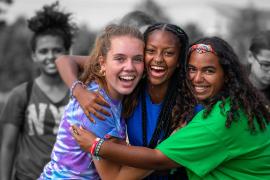Snapshots of camp’s history remain steadfast in the minds and hearts of camp pioneers, moving beyond the boundaries of time. In a series of interviews with several American Camping Association (ACA) Pioneers, Camping Magazine chronicles the spirit of camp’s yesterdays. Let us honor the past and embolden the future of camp — through the eyes of pioneers . . . .
Camp’s very nature is evolving. As the earth transforms with the seasons, organized camps have reshaped and molded outdoor recreation in powerful ways over the decades, tearing down the walls of indifference to the environment, prejudice, and education, all while enjoying the changing trends in clothing, transportation, and food preparation (hotdogs roasting on sticks and s’mores seem to be permanent delicacies . . . .).
Open Spaces and Softer Steps
Before urban sprawl infringed upon the land, camps were settled on large plots of acreage. In the ’20s and ’30s the wilderness went on for miles, now the lakefront wilderness factor is only in the trees. “The wilderness isolation is not like it used to be. We were used to the freedom of the woods, and we decry its passing as the years go by,” notes Fred Rogers. Stores grace every corner it seems, but the modern camper does not complain. Rogers explains, “They are used to the commercialism around them.”
In the ’50s, campers went about their tasks unfettered by environmentalism. They drank from clear streams and lakes oblivious to pollution. “Our only rule was that we scrubbed our dishes at the lake down shore from where we drank water and swam. We cut down saplings for tent poles, and dug trenches so the rain would not seep under our tents,” says Robert Telleen. “I remember seeing canoes draped in water lilies that campers would gather in the bogs.” The camp staff of today tread lightly on the land, teaching environmental awareness and recognizing their impact on nature.
Diversity Becomes a Goal
Alan Stolz tells of his purchase of Camp Cody in 1959. At the time, the camp had a Middle-Atlantic, well-to-do, suburban clientele and limited outdoor programs. Stolz and his partners made sweeping changes to the camp: “We expanded the Cody programs to include team and individual sports, an industrial arts curriculum, nature and science outdoor programs, ocean marine biology, and more high-adventure trips. The walls of segregation came down. We opened segregated buildings, totally opening the camp. We hired staff for what they could offer the kids, and we opened hiring to international staff.”
Recognizing the Value of Camp
Camp has been incorporating more and more professionalism over the years. Camp has always been touted as educational, but no anecdotal evidence was available in the ’50s through the ’90s. Only until the late ’90s, when the American Camping Association (ACA) began focusing research into the area of outcomes, has camp begun to be understood as a valued educational experience.
Much of the strides that have been made in the recognition of camp’s value stems from camp directors acknowledging and fulfilling their camps’ stated missions. “A person I knew in church had a vision of starting a camp for kids to just have fun, and that was the mission for many years. ACA standards and the Camp Director Institute really pushed camp executives to define their mission. As a result, camp directors more often define segments of their camp’s mission, including health, safety, and development — it’s [the mission] now spelled out and equitable with healthy development goals for children,” explains Telleen.
Changing Trends
Clothing
What did campers wear through the decades? Jean G. McMullan describes the evolving uniforms of Alford Lake’s campers:
“In 1915-1929, the standard wear for girls was long, serge royal blue bloomers worn with long black stockings and white or blue pullover blouses with smaller collars. Former director of Camp Wyonegonic in Maine, Helen O. Cobb, age 92, reports that in the ’30s as a young counselor, she was incensed that teenaged campers were required to continue to wear long black stockings while younger campers were allowed to wear socks. She personally led a midnight raid on all the black stockings in senior camp, hiding them up the steep hills in the woods. The next day the director simply went to town and bought all the white socks he could find to outfit the rebelling seniors. And gone was an era!
“Clothes were sent to camp in wooden trunks in the early days. Now we have campers arriving with canvas wheeled roll duffels and plastic trunks — foot lockers are popular, too.
“The ’30s-’50s saw cotton, must-iron blouses change to knit (no-iron) shirts with camp logos. From high-laced shoes in the early days to sneakers to light strap-on Velcro® sandals to heavy hiking boots — the footwear continues to change. From heavy jackets in the past to camp wear with the modern-day, rain repellent Gortex jackets — apparel becomes easier to put on and more light-weight.”
Transportation
McMullan recalls the early decades (1910-1930) of Alford Lake when campers arrived by steamship from New York and Boston to the Rockland, Maine, docks. They spent the night on the ship and arrived in the morning. They transferred to horse-drawn buggies and, later, to open truck “buckboards.” Today they arrive by chartered buses, small planes, limos, and private cars.
Transportation at camp from the 50s on has made dramatic changes in risk management and safety. “It was not unusual for the back of a wooden-sided pick-up truck to be loaded with thirty campers as they drove us through the woods. Carrying campers in open truck beds was common. The safety aspect was different then. Now we have a balance between safety and unrestrained fun,” explains Telleen.
Food Preparation
Camp foods in the ’50s were made from scratch. Camp staff would carry spice kits. No prepared foods were available. Campers might carry dry macaroni and wedges of cheese that would not go bad for the day and make macaroni and cheese. On the first day of a trip, a group of hungry campers might take along pounds of frozen hamburger that would thaw during the day. They would cook a meat casserole or hamburgers later that day. “We would do some creative cooking, too. We would bake cakes and pies in the reflector ovens. Baking in reflector ovens is a real art — you must stack the wood to burn at a 90-degree angle, in a rock-lined fire pit so that the reflector oven can carry the heat around and behind. We would use tongs to turn the cake. I can remember horrible disasters with the cakes dotted with charred wood. Or, you might wind up with a wonderfully baked cake,” remembers Telleen.
The joy, discoveries, and teachable moments that camp offers children and adults have endured through the decades — some things never change. With the advent of ACA standards in the ’40s, safety and risk management practices have evolved and become the norm. Telleen explains, “In those days we had a cavalier attitude, like we were going on holiday and nothing bad could happen. Now the safety practices at camp are vastly different and rightly so.” While the days of campers sitting on rooftops, draping canoes with water lilies, or riding in old pick-up trucks through winding, narrow roads in the woods are over, a safer, more environmentally conscious camp prevails and will continue to enlighten generations to come.
Teresa Nicodemus previously served as the assistant editor of Camping Magazine.
Originally published in the 2003 July/August issue of Camping Magazine.



